and historical purposes, all rights reserved.
This page is copyright© by
This page may not be sold or distributed without
the expressed permission of the producer
I have no connection with any camera company
This camera manual library is for reference
and historical purposes, all
rights reserved.
This page is copyright© by ![]() ,
M. Butkus, NJ.
,
M. Butkus, NJ.
This page may not be sold or distributed without
the
expressed permission of the producer
I have no connection with any camera
company
On-line camera manual library
If you find this manual useful,
how about a donation of
$3 to:
M. Butkus, 29 Lake Ave.,
High Bridge, NJ 08829-1701
and send your e-mail
address
so I can thank you.
Most other places would charge
you $7.50 for
a electronic copy
or $18.00 for a hard to read Xerox copy.
This will help me to continue to host this site,
buy new manuals, and pay their shipping costs.
It'll make you feel better, won't it ?
Back to main camera manual page
Voigtlander Vitessa with Light Meter
Another Vitessa, direct scan

Better "Pictures - faster and easier
Your VITESSA is a 35 mm camera made on new constructive principles which has
been "built into your hands". You will very quickly realize just how much the
simplified handling will help you in obtaining better pictures.
But even
the VITESSA cannot manage entirely without some technical advice, and so we
recommend you first of all to study these instructions carefully and to make
yourself familiar with all the controls before taking your first pictures.
And please don't forget that a camera of this high quality is an instrument of
the finest mechanical precision. Even though it is of very robust build it still
wants to be treated with care and understanding. It will thank you with
wonderfully fine and sharp pictures over many years.
Voigtlander VOIGTLANDER A.G.
BRAUNSCHWEIG
YOU WILL FIND: ON PAGE:
| LOADING |
Removing the Back - Inserting the Cartridge Setting Film Counter and Film Indicator Closing the Back - Opening the Front Doors Preparing the Film for Exposing |
5-6 7 |
| SETTING THE CONTROLS |
Aperture or Stop - Shutter Speed Rangefinder Zone Focusing |
11-13 |
| EXPOSURE |
Combi-Plunger - Shutter Release - Automatic Lock... Single Shots - Rapid Sequence Shots Time Exposures |
17 18-19 20 |
| UNLOADING |
Closing the Camera . Rewinding the Film - Changing partly exposed films.. |
|
| APPENDIX |
Practical Hints Speed-Synchronized Flash Flash Case "Kontur" View-Finder Filters - Lens Hood - Close-Up Lenses Aperture and Depth of Field Care of Camera and Lens |
24 |
 |
FRONT VIEW - Front doors
open
A. Aperture Scale |
 |
BACK VIEW - Front Doors
Open
L. View- and Rangefinder Eyepiece |
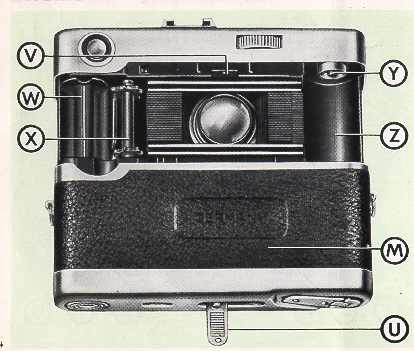 |
INTERIOR - Front Doors
closed
M. Camera Back (Removed) |
REMOVING THE-BACK
|
|
|
| Hold the camera in your left hand, with the four fingers lying against the lower edge of the front doors 10. Lift up the latch and give it a quarter turn so that it points to "Off" (2) , grip the latch and pull the camera back off the body (3), using your left thumb which lies against the back to help in pushing it off. |
|
INSERTING THE CARTRIDGE
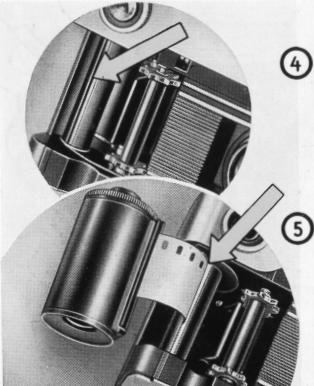 |
Turn the film transport shaft by the cogs until the slit in the take-up spool next to it faces upward (4). |
Now push the tongue of the film as far as possible into the slit of the spool.
The upper edge of the film must touch the inside of the upper rim of the spool (5). Now pull the cartridge across the transport shaft and the film aperture and insert it in the film chamber (6).
SETTING FILM COUNTER AND FILM
INDICATOR
CLOSING THE BACK
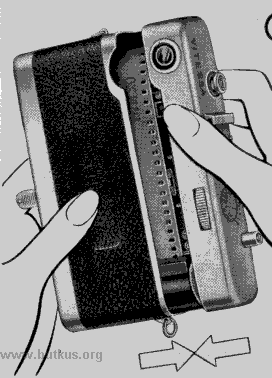 Push the camera body and back together again (11). |
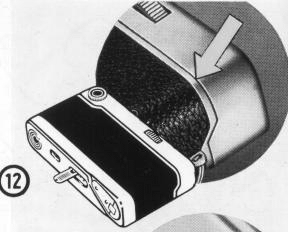 If the back will not close completely (12), move the latch and the open rewind crank slightly to and from (13).
|
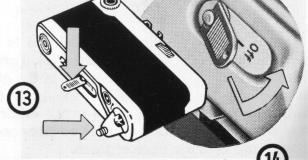 Then turn back the latch and fold it down (14). Only now is the camera fully closed and light tight. |
OPENING THE FRONT DOORS
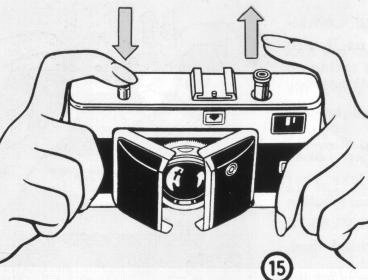 Hold the camera in both hands, point it slightly downwards, and press the release button (15). The two doors will spring open and expose the shutter and lens. The fully open camera appears as shown in illustration. |
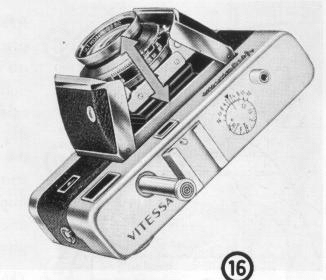 |
Caution: It is advisable to use the left index finger for braking slightly the movement of the combi-plunger as it slides out at the same time. If the lens does not come forward all the way, gently pull one of the front doors outwards. |
PREPARING THE FILM FOR EXPOSING
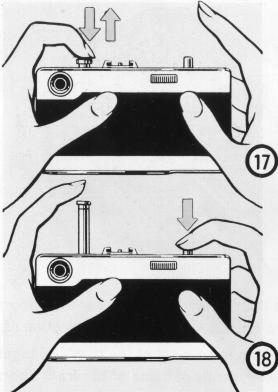 |
Press down the combi-plunger as far as it will go and allow it
to spring up again. Press down the release button and keep it depressed is. Work
the combi-plunger once more 19. Now take your finger off the release button and
push down the combi-plunger for the third time. |
The film is now ready for the first exposure and
the film counter shows "0" From now on it will show the number of exposures you
have made.
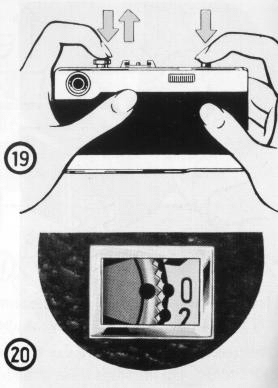
SETTING THE APERTURE
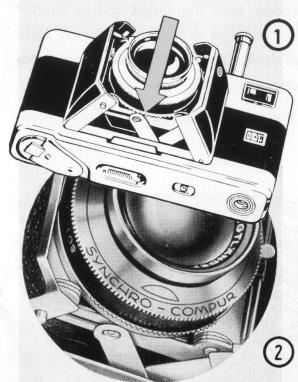 |
To set the aperture or stop turn the semi-circular wheel underneath the shutter housing ® and (. It is best to use your index finger. |
All the stops on the scale which
rotates during setting click into position opposite the tip of the A mark ®,
making accidental changes impossible. The scale and index mark are visible from
above (4).
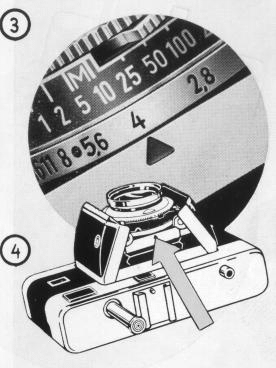
SETTING THE SHUTTER SPEED
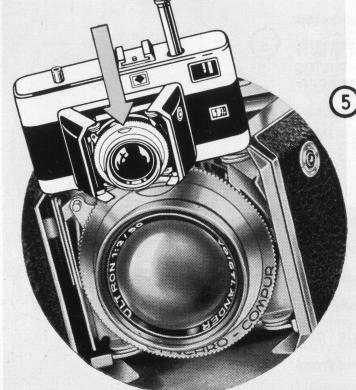 |
To set the shutter speed, turn the large, milled
shutter speed ring Ts. All the settings are easily read off from above ©. Set
the red dot on the shutter speed ring opposite the required shutter speed (ill.
(7)= 1/2 sec). |
The shutter has already been tensioned during loading (see p. 10).
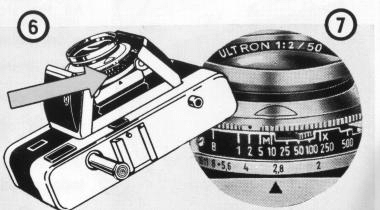
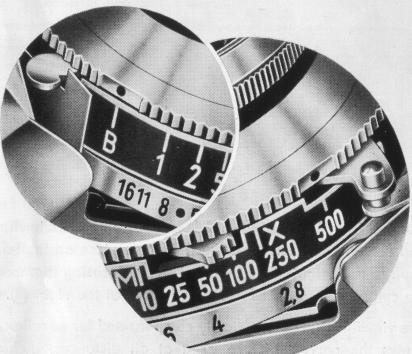 |
The figures on the shutter speed scale stand for fractions of a
second, except for the "1"/ which means one second. Intermediate speeds can be
set EXCEPT between '/,o and 1/25 second, and between 1/250 and 1/500 second. |
At the extreme left is the "B" setting for time exposures 80; at this setting the shutter remains open so long as the release is kept pressed down. At the extreme right is the setting for 1/500 second (9) . This can only be set before tensioning the shutter.
THE VIEW- AND RANGEFINDER
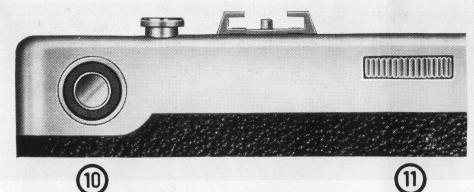 |
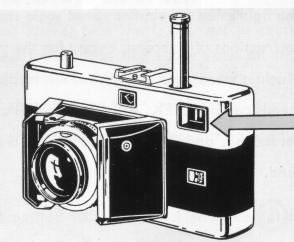 |
| The precision finder of the VITESSA is a
combined viewfinder and rangefinder. Through the large eye-piece on the left
(10) you see the bright picture area with the focusing diamond in the centre.
The milled focusing wheel is at the right (11) . The viewfinder is automatically compensated for parallax and shows the correct picture area at all distances, including close-ups (3.3 to 7 feet). |
Make sure that your fingers are clear of the left-hand front window when using the finder. Finger prints on this window can also affect the focusing efficiency of the rangefinder. |
SETTING THE RANGEFINDER
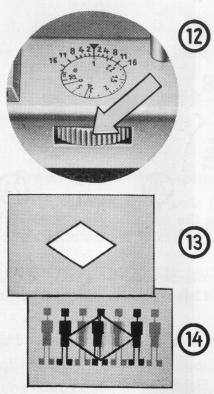 |
Hold the camera in shooting position. Put
your right thumb on the milled wheel 12. Bring your eye right up to the
eye-piece of the finder so that you can see all the four corners of the image.
Make sure you are looking straight through the centre. As long as the
rangefinder is incorrectly focused the focusing area 13 shows a double image of
the subject .. Now turn the focusing wheel until the double images in the
focusing diamond (ill. 1s for a horizontal and 16 for an upright example)
coincide and fuse into one sharp image 17. The lens is now focused on exactly
the correct distance. Note: With horizontal pictures watch the vertical lines of the subject; for upright views focus on the horizontal lines. |
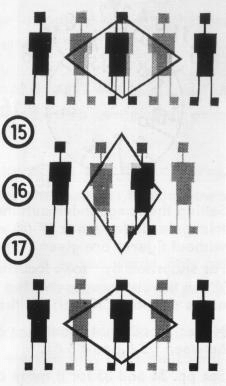 |
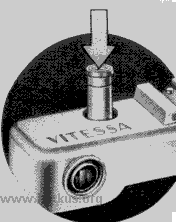
Setting the rangefinder automatically moves the
focusing scale as well. Above the scale, in the centre is the triangular index
mark ![]() (18) to which points exactly to the focused distance. The values of the distance
settings without figures are given on page 35.
(18) to which points exactly to the focused distance. The values of the distance
settings without figures are given on page 35.
For snapshots by "zone focusing" without using the rangefinder the distance
scale carries two special marks. When the distance is set at the ![]() mark (10 feet) (19), everything between 8 and 15 feet will be sharp; when set at
the ( ) mark (30 feet) (20), the zone of sharp focus extends from 15 feet to 00
(infinity).
mark (10 feet) (19), everything between 8 and 15 feet will be sharp; when set at
the ( ) mark (30 feet) (20), the zone of sharp focus extends from 15 feet to 00
(infinity).
Note:
Good light conditions are necessary for these settings and the aperture has to be set at the red dot between f/5.6 and f/8 (21).
See pp. 34 and 35 for a more detailed explanation of "Aperture and Depth of Field".
COMBI-PLUNGER . SHUTTER RELEASE . AUTOMATIC LOCK
A single finger pressure on the combi-plunger transports the film by one frame (automatically lifting the film pressure plate), tensions the shutter, counts the exposures and releases the shutter lock.
Always press the combi-plunger down as far as it will go. If this is not done it will lock itself in the lower third of its way and will only free itself after being pressed down completely once again.
Pressing the combi-plunger several times without making any exposures will do no harm. With the longer speeds
(1/2and 1 second) always wait for the shutter mechanism to run down fully before working the plunger again.
Always press the release button down in one gentle movement and never jerk it
- you would only get blurred pictures. The release button is threaded inside to
take a cable release for time exposures (see p. 20).
The automatic
shutter lock prevents double exposures as well as blank (unexposed) frames. The
shutter is tensioned only after a previous exposure; equally, the release button
can be worked only after the combi-plunger has been pressed down.
SINGLE SHOTS
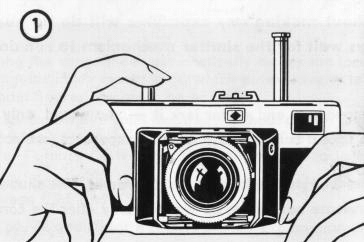 |
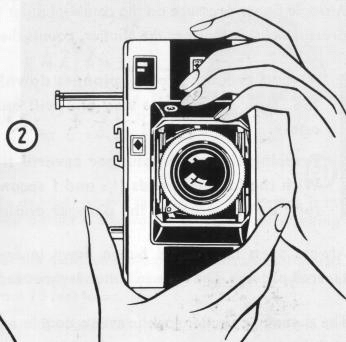 |
We recommend holding the camera as shown in
the illustrations. With horizontal pictures (1) use the index finger of your
right hand to release the shutter, but use the thumb for upright (2) pictures. After exposing, put the camera down and with your thumb press down the combi-plunger as far as it will go. |
RAPID SEQUENCE SHOTS
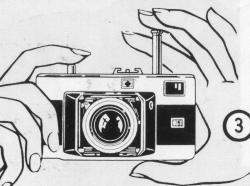 |
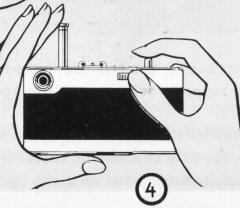 |
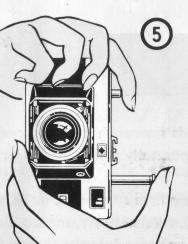 |
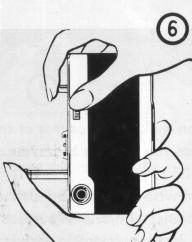 |
TIME EXPOSURES
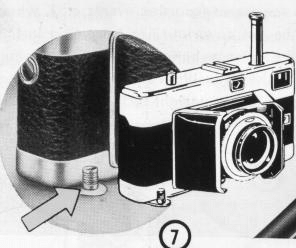 |
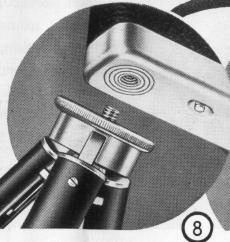 |
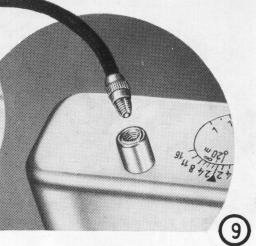 |
When making exposures at speeds slower than 1/25 second,
you should not use the camera held in the hand, unless you happen to have
exceptionally steady hands or when you can support your arms or lean against a
solid object.
Otherwise the camera must have a firm support. One way is to
fold the rewind crank outwards and to stand the camera on a level surface (7).
Alternatively, mount it on a tripod (8). For time exposures a cable release with
locking device is useful; this screws into the thread inside the release button
(9).
CLOSING THE CAMERA
|
|
|
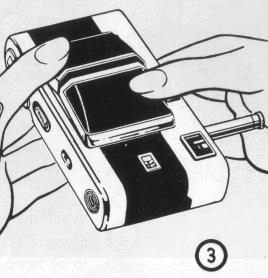 |
The front cover of the shutter carries two red pressure marks (1). To close the front doors, hold the camera in both hands, press with both thumbs simultaneously on the two marks (2) and push the shutter and lens into the camera body. Then close the camera by folding down the two doors until they engage with an audible click (3) and push home the combi-plunger. Finally press the release button down to its first pressure.
UNLOADING THE CAMERA
|
When the film counter indicates the number of the last exposure (1) or the combi-plunger cannot be fully depressed (2), the whole film has been exposed and has to be rewound into the cartridge in this way: |
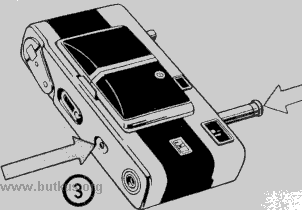 |
|
Close the front doors, depress the rewind button on the underside of the camera once quickly (no constant pressure), and at the same time press home the combi-plunger (3). Unfold the rewind crank (4) and turn it in the direction of the arrow until the film counter dial stops moving. Now pull the camera back off in the way described previously and take out the cartridge. |
|
| CHANGING PARTLY EXPOSED
FILMS
If you wish to exchange a partly exposed film for one of a different type (e. g black-and-white for colour), first make a I note of the number of exposures already made (1). Then rewind the film in the normal way but stop winding immediately the film counter ceases to rotate (2). Now open the camera back and remove the cartridge. When reloading the partly exposed film, start off in the usual manner (3). Then half open (4) the two front doors, press down the release button and keep it depressed while pushing the combi-plunger down fully as often as necessary until the film counter shows the number following the one you noted down (5). |
|
|
|
|
|
|
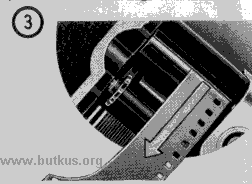 |
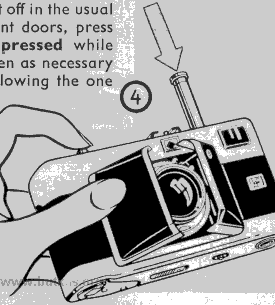 |
PRACTICAL HINTS
• If the beginning of the film is not properly
anchored on the take-up spool, it may slip out and will not be advanced on
pressing the combi-plunger. To check: Unfold the rewind crank and let it hang
down. Hold the camera horizontally to see whether the crank turns when you work
the plunger. If it does not move, the beginning of the film has slipped out and
must be fixed afresh to the take-up spool after opening the camera back (see
page 6).
• Deliberate double exposures (e. g. for trick shots) are quite
easy, despite the automatic double exposure lock. Proceed as follows: After the
first exposure depress the rewind button, let go, and then fully push in the
combi-plunger. This tensions the shutter without advancing the film, and you can
make a second exposure. Then work the combi-plunger as already described.
If in doubt about the correct exposure, expose black-and-white film generously;
a certain amount of overexposure does not matter much. Underexposure, however,
always gives poor results. With colour film, exposure must be accurate; use an
electric exposure meter at all times.
SPEED-SYNCHRONIZED FLASH SHOTS
| The SYNCHRO-COMPUR makes possible flash shots of moving subjects at any shutter speed, including '/500 second. You can use the flash as the sole light source or else combine it with daylight or artificial light. With against-the-light shots you obtain excellent illumination of the shadow areas. All flash units on the market, including electronic flash, can be used with the shutter. Light-weight guns can simply be pushed into the accessory shoe; larger ones are mounted on a bracket which is screwed into the tripod bush and kept at the left-hand side of the camera (see. ill.). |
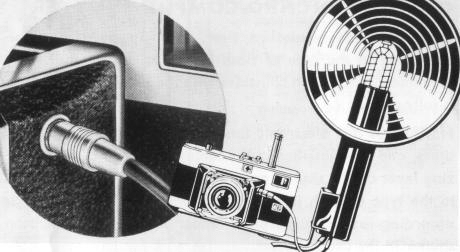 |
The flash lead which connects the flash gun with the camera carries on one end a round plug which is inserted into the sunk socket in the left-hand front door. The other end has the plug for the flash gun. This is often a safety plug with one thin and one thick pin which can be connected only in the correct way.
THE SETTINGS ON THE SYNCHRO-COMPUR SHUTTER
| Synchronization, exposure time, and aperture must be set
according to the type of flash in use to ensure that the peak brightness of the
flash coincides with the instant when the shutter is fully open. Flash bulbs and electronic flash tubes vary in their firing delay times, and are classified in the table on the right. The synchronizing lever on the shutter must be set to either X or M, according to the type of flash in use (see ill.). Then set the shutter speed according to the values given under X and M and tension the shutter in the usual way. |
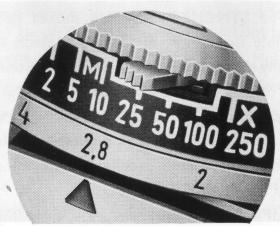 |
For setting the correct aperture look up the
so-called "guide numbers", which will be found in the instructions supplied with
all types of flash. The correct aperture number will be found by dividing the
respective guide-number by the distance in feet between the camera with flash
and the subject. (Aperture = Guide-Number / Distance)
X-Setting
The contact closes at the moment when the shutter is
fully open.
M-Setting
The contact closes
a short time-corresponding to the firing delay of class M bulbs - before the
shutter begins to open.
Electrical Data - Click here for chart of Flash Bulb Settings
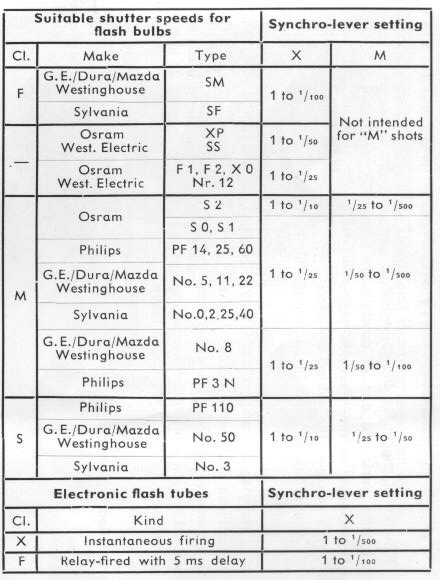 |
The flash contact will carry the
firing current of all types of electronic flash tubes. With flash
bulbs it will carry a temporary load of 10 amps at 24 volts, thus
allowing simultaneous firing of several bulbs connected in parallel.
The longest permissible exposure time in this case is '/,o second. Caution: The flash contacts must never be used to fire bulbs from 110 or 220 volt supply mains. To avoid wiring up the leads the wrong way round, get an electrician to fix the cable to the flash gun in the first instance, since the outer pole of the flash socket is earthed. |
| The use of flash has become a matter of course for the
up-to-date amateur photographer, not only after dark, but also in daylight. A
flash bulb can give useful illumination to the often too black shadows of
against-the-light shots; it can give the subject an effect of sunlight on a dull
day, enable you to take hand-held snapshots with insufficient natural light, and
so on. To save you the inconvenience of carrying a flash gun separately, Voigtlander have created for you a Flash Case which carries in the smallest possible space both your camera and your flash gun. When you open the case and have inserted the lamp and done the setting you are immediately ready to use the flash gun because you can leave the flash lead connected to the camera even with the case closed. Please ask your dealer for the detailed prospectus. |
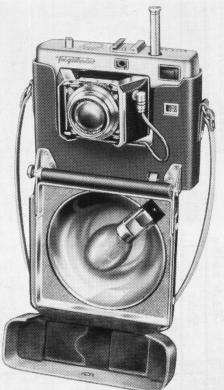 |
THE "KONTUR" PUSH-ON VIEWFINDER
| Quicker sighting of moving subjects and clearer presentation of pictorial scenes - those are the invaluable advantages of the KONTUR viewfinder. The large eye-piece of /s inch diameter gets rid of all the former viewfinder troubles, particularly for spectacle wearers. |
Keep both eyes open while sighting the subject. The
eye watching the subject directly will see it in its natural size and
brightness, while the eye looking into the finder sees the frame outlining the
picture area. You will see the two separate impressions as one single picture in
your normal field of view.
A dotted line indicates the parallax error with
close-ups from 3.3 to 6.6 feet.
| Caution: Never allow direct sunlight to reach the eye-piece of the finder. |
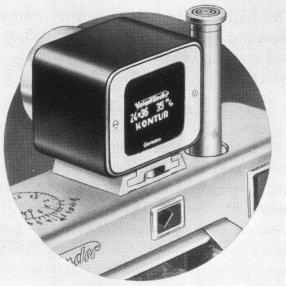 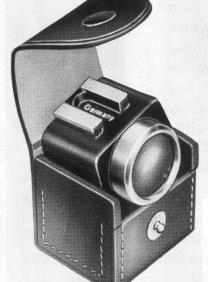 |
Push the KONTUR finder into the accessory shoe from the front of the camera and push it back as far as it will go.
FILTERS - LENS HOOD
| The high-efficiency lens of your camera will satisfy your most
exacting demands for superb definition, but you can greatly enhance the mood of
your pictures and obtain special effects with the help of filters. It is surprising how often you can attain pictorial effects with these simple aids which are quite unobtainable without them, and they should not be missing from any photographer's equipment. Voigtlander Filters are made of massive, spectroscopically tested, glasses and ground absolutely parallel. Every filter is fitted in a bayonet mount and can remain in position on the camera when this is closed. |
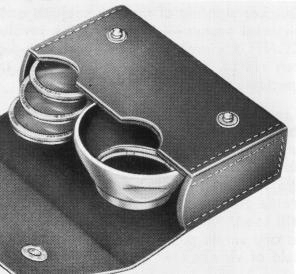 |
The lens hood is indispensable for
against-the-light shots and those taken with artificial light, for it screens
the lens from all stray light. It also serves to protect the lens from raindrops
in bad weather conditions.
The Leather Case for Accessories fits on the
strap of the camera case and can take three filters and the lens hood.
|
VOIGTLANDER FILTERS |
|
|
Type and Exposure Factor |
Effect |
|
Slight correction, for outdoor shots with short exposures, action and snapshots. Use when the sun is low in the sky |
|
Universal filter for landscapes and other outdoor work: indispensable for snow |
|
Lightens green in landscapes. Counteracts the green deficiency of pan-red films. Recommended for artificial light portraits |
|
A powerful filter which absorbs a great deal of blue light. Reduces the atmospheric haze of distant views. Lightens yellow, red, and green |
|
Absorbs ultra-violet rays at high altitudes and by the sea. Counteracts the undesirable blue cast with colour film |
|
For using artificial light type colour film in daylight or with daylight type artificial light (electronic flash). Special instructions are enclosed with every filter. |
CLOSE-UPS WITH SUPPLEMENTARY LENSES
Do not miss this highly interesting branch of photography which, unfortunately, so many amateurs neglect. Large-scale pictures of flowers, butterflies, and other small animals, small "objects d'art" etc. may yield effects of extraordinary beauty. With the help of Voigtldnder Focar Lenses you can, moreover, excellently copy pages of a book, stamps, or small pictures. Care, however, is recommended in portraiture, as perspective may easily appear distorted in this case.
The effect of the Focar lenses is that they shorten the focal length: this permits the camera to be brought much nearer the subject. Thus the subject is reproduced on a much bigger scale.
With the Voigtldnder Focar lenses you have three close-up ranges at your disposal, viz:
FOCAR 1 (1.25 Diopters) from 2' 71/2" to 1' 5 1/2"
FOCAR 2 (2.25 Diopters) from 1' 5' 1/2" to 1'
FOCARS 1 and 2 combined (3.5 Diopters).... from 11'/4" to 8'/4"
FOCUSING TABLE
|
Distance scale on camera set to |
Plane of sharp focus when using |
||
|
Focar I |
Focar 2 |
Focars 1f- 2 |
|
|
00 |
2' 7'/2" |
1' 5'/2" |
11'/4' |
|
2' 6 1/4" |
1' 5" |
11" |
|
2' 5 '/4" |
1' 4 3/4" |
11" |
|
2' 3" |
1' 4" |
10' /2" |
|
2' 1 '/2" |
1'3,/d' |
10'/ ' |
|
2" 1/2" |
1 3" |
10'/a" |
|
1"11'/." |
1'2'/a" |
10" |
|
1111" |
1'2'N' |
10" |
|
1110" |
1'2" |
9'/u" |
|
1'8'/Q |
11'/2' |
9'/z |
|
1'8" |
1'19' |
|
|
1' 7" |
1' 1 " |
9", |
|
1'6" |
1"/z' |
8'/!' |
|
1' 5'/2" |
1' |
8'/e" |
HOW TO USE THE FOCAR LENSES:
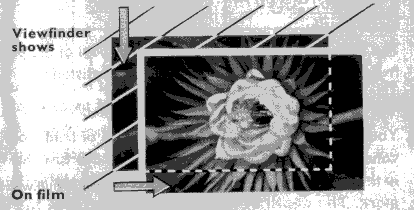 |
With close-ups the viewfinder image does no longer correspond to the area reproduced, but is shifted upwards and to the left (parallax - see ill. below). With the FOCAR 1 the difference is up to 1/8, with the FOCAR 2 up to 1/4, and with the FOCARS 1 and 2 combined up to 1/2, of the viewfinder area. |
APERTURE AND DEPTH OF FIELD
The iris diaphragm regulates the amount of light which reaches the film, and
thus controls the exposure as well as the depth of field. Note that the aperture
becomes smaller as the aperture number becomes larger, and vice-versa. Going
from one number to the next, the exposure time required is always doubled or
halved respectively. For example:
| Aperture | f/2 | f/2.8 | f/4 | f/5.6 | f/8 | f/11 | f/16 |
| Exposure (e. g.) | 1/500 | 1/250 | 1/100 | 1/50 | 1/25 | 1/10 | 1/5 second |
The "depth of field" of a picture is that part of
the photographed area which is still reproduced fully sharp in front of, and
behind, the actual focused distance.
Note: Large
aperture = small depth of field; small aperture = great depth of field.
You can read off the extent of the depth of field from the focusing scale and
the depth of field indicator. The values of the unnumbered distance settings are
shown in illustration (. After focusing the V mark points to the exact subject
distance. Two series of aperture numbers are arranged symmetrically on either
side of the mark.
The depth of field then extends
from the distance shown by the figure opposite the selected aperture number on
the left to the distance opposite the identical aperture number on the right.
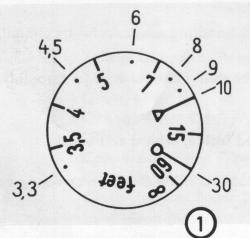 |
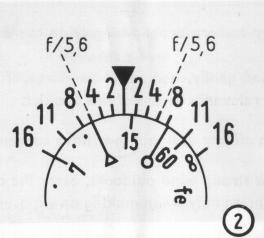 |
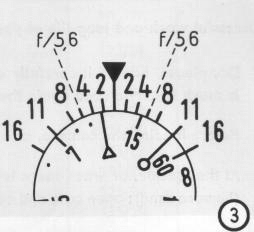 |
• For Example, if you have focused on 14 feet, the
depth of field scale shows that at f/2 everything will be sharp from about 13 to
16 feet, at f/4 from about 12 to 20 feet, at f/5.6 from about 10 to 25 feet, at
f/8 from about 9 to 30 feet, at f/11 from about 8 to 60 feet, and at f/16 from
about 7 feet to 00 (infinity) T.
• To find the most suitable settings
for aperture and distance for a given depth of field, set the limits of the
sharp zone required opposite two equal aperture numbers. For instance, for a
depth from about 7 to 30 feet, illustration ® shows that you have to stop down
to f/11. The indicator then automatically shows the required distance setting.
CARE OF CAMERA AND LENS
Successful work and long life
of your camera depend largely on correct handling and careful treatment.
•
Do, please, handle it carefully and gently, and never use force. If anything
should not go smoothly, it is much better to read again the relevant sections of
this booklet.
• Before loading the camera, clean off any dust that may
have collected inside, with a soft brush.
• At the seaside, or when there
is a strong wind outdoors, carry the camera in its closed ever-ready case
(beware of sand); open case and camera only when making an exposure.
• You
must avoid finger prints on the lens because they spoil definition. The windows
of the view- and rangefinder must also be kept clean, otherwise you will find it
difficult to focus correctly.
• The lens is coated even on the outer
surfaces (anti-reflection layer). It may be cleaned with a very soft brush, or a
piece of soft, clean, linen. Grease spots may be removed by gentle dabbing with
a wad of cotton wool moistened in medicinal alcohol or ether.
| ACCESSORIES FOR THE VITESSA | ||
| Designation Art. Nr. | ||
| Yellow Filter G 1 (light) in
Bayonet Mount Yellow Filter G 2 (medium) do Green Filter Gr do Orange Filter Or do Ultra-Violet Filter UV do Conversion Filter Type A do Close-Up Lens Focar 1 do Close-Up Lens Focar 2 do |
125/21 125/22 125/26 125/28 125/29 125/27 125/23 125/24 125/20 90/094 125/19 335/36 90/104 90/083 90/122 |
|
| Lens Hood (Metal in Push-On
Mount) Accessory Case |
||
| for Filters, Focar Lens and Lens Hood | ||
| Flash Case | ||
| KONTUR Viewfinder | ||
| Camera Ever-Ready Case in Brown Hide with Carrying and Neck Strap |
............. | |
| Leather Case for KONTUR Finder Neck Chain, Brass, Chromium-Plated |
||